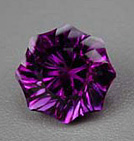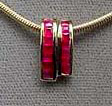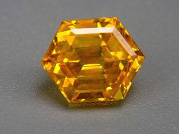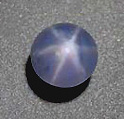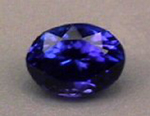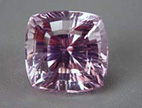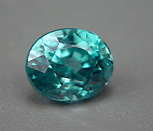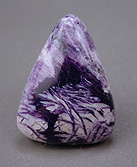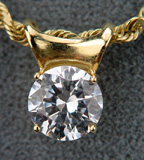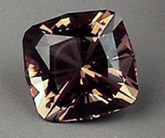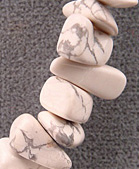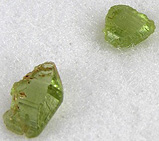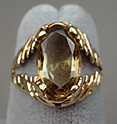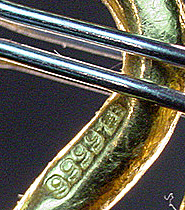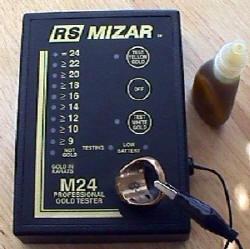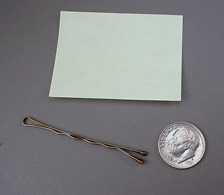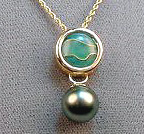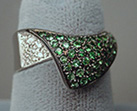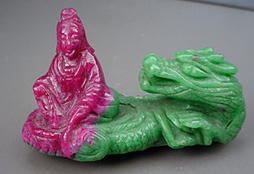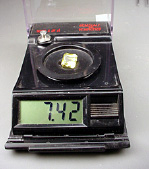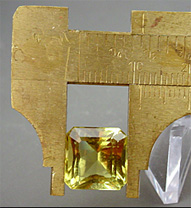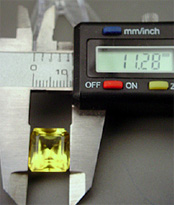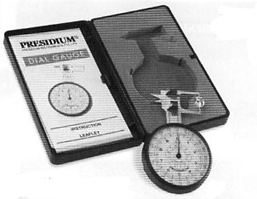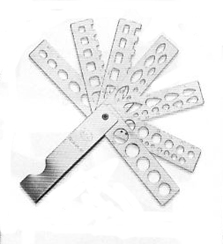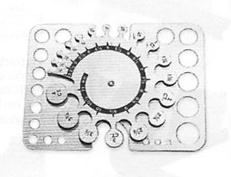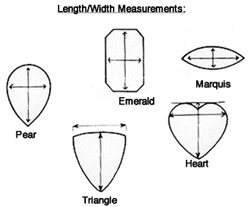
| NAMING AND MEASURING GEMS Naming
Gems :
Species :
A gem species is a mineral that has a definite chemical formula, and has a particular three dimensional structure. In regards to that structure, gems can have a crystalline (highly regular and organized), or amorphous (less organized) structure.
An example of a gem species is quartz. All quartzes, whatever their other characteristics, share the same chemical formula : SiO2 and are members of the hexagonal crystal system. (We'll be looking at the characteristics of the various crystal systems in a later lesson). The species "quartz" encompasses many quite different looking gems, though, from amethyst and citrine, to agate and jasper, to rutilated quartz and tiger'seye.
Another example of a gem species is corundum (commonly known as sapphire). All corundum gems share the chemical formula: Al2O3 and are members of the trigonal crystal system.
Variety :
A gem variety
is composed of a sub-group, within the species, that shares distinct
and notable characteristics, such as color, degree of transparency,
inclusions, or optical phenomena with others of its kind. Not
every gem species has multiple varieties, for example, there are
no separate varieties within the gem species peridot.
Amethyst
Agate
Ruby is the variety name for red corundum, yellow sapphire is yellow corundum and star sapphire is translucent to opaque corundum that shows the optical phenomenon of asterism (forms a star figure from reflected light). The only variety of corundum that is simply called "sapphire" without any modifier is blue sapphire, all other colors have their own variety name (like ruby) or use a modifier like star, yellow, pink, white, etc.
The
individual species of the group share membership in the same crystal
system, but although the chemical formulas amongst group members
are very similar, they are not exactly the same throughout the group.
Typically, the formulas gradually change by substitution of a set
of chemical elements from one end of a continuum to the other.
All garnets, whatever their individual species and varietal designations, are members of the isometric crystal system and are metallic silicate minerals with various proportions of Ca, Fe, Mg, Al, Cr and Mn substituting for each other within a similar chemical formula.
(To amplify: the generic formula for any garnet is A 3B 2Si 3O12 where the "A" position can be occupied by iron, calcium, manganese or magnesium, and the "B" position can be occupied by aluminum, iron, titanium or chromium. The rest of the formula is standard for all gems known as garnets).
Garnet Group Gems :
Group: garnet, Species: Spessartite
Group: garnet, Species: grossularite, variety: Tsavorite When species or variety names come from proper nouns such as those designating a person (like Kunzite, named for G. F. Kunz, or Spessartite, named after the type location, Spessart in Germany), they are capitalized. Otherwise lower case is used, as in grossularite, agate and amethyst.
In addition to the official names given to gems, there are also a multitude of trade names, brand names, and misnomers that are in use. In fact, just as happened in the history of biology, the confusion over which mineral or gem was called what, where, by whom, has led to the development of a rigorous system for international naming of minerals and gems. Although this formal system is used by professionals, students, and serious gem enthusiasts among the public, many other names are still in use and can create confusion.
Trade Names :
In modern times, trade names have most often developed when a new gem material is first discovered and marketed, as a way to "romance the stone". Let's say you are in Tanzania and you mine a facetable, but insipid looking light brown, transparent form of the mineral zoisite. You discover that heat treating will turn it to a gorgeous blue-violet color. The correct descriptive term would be: heated brown zoisite.
Who would rush out to buy that? But, what if you call this gem something exotic and evocative of its foreign mine site, like "Tanzanite" now you something more marketable!
Heated brown zoisite = Tanzanite
Other examples of names which started out as marketing ploys and ended up on the officially sanctioned list include: "Kunzite" for pink spodumene, named for the famous early 20th century gem explorer and writer, G. F. Kunz and, "Tsavorite" for green grossular garnet named for its original mine locale (Tsavo National Park in Kenya).
Kunzite
Tsavorite
Within the last few years a deposit of strikingly marked purple and white opalized fluorite has been sold as "Picasso Stone" among other creative trade names. Although you still see this and various other terms in use, most folks in the gem world seem to be sticking with the more mineralogically descriptive name, opalized fluorite.
Blue Pectolite or "Larimar"
"Picasso
stone" or Opalized Fluorite Brand Names :
Brand names usually develop when a seller is trying to differentiate their product from other identical or very similar ones. A case in point each of the two major home shopping channels sells its own brand named version of the diamond simulant cubic zirconia. QVC sells it as "DiamoniqueTM" and HSN as "AbsoluteTM". Cubic zirconia, or CZ, is widely sold under its generic name at lower prices, so here, the name becomes a way of "branding" that creates "added value" in the marketplace. We are all quite familiar with this concept in the marketing of common food staples like catsup and mayonnaise, but it is every bit as effective a device in selling gems and jewelry.
Misnomers
:
Smoky Topaz" for Smoky Quartz
"White Turquoise" for Howlite One of the few vintage misnomers that can still occasionally be heard, even among modern day jewelers, and reputable gem dealers, is "smoky topaz". For many years this name was used incorrectly for the gem smoky quartz. Probably, it started out innocently enough, as many such names do, as a language translation failure, or an inability to correctly identify the species. Its use grew, however, even after the true identity was established, due primarily to the profit motive. Topaz is a generally more valuable gem than quartz, so by calling this variety of quartz by the topaz misnomer, it could sometimes be sold at higher prices to the unwary.
In their defense, individuals from earlier centuries who searched for, and traded in gems, did not have the gemological knowledge or instruments necessary to make the exacting identifications of today. Usually the location, color, and some simple physical characteristics like hardness, luster, crystal habit, and cleavage were the only basis for naming, and many incorrect identifications were made.
Examples can be seen in the misidentification of some of the famous gems of history, such as Cleopatra's emeralds (which were probably peridots). Or as in the case of the "Black Prince's Ruby" in the Crown Jewels of England, which turned out, upon testing, to be a spinel.
Green rough stones, collected circa 1900 from the now exhausted St. Johns Island mine in Egypt, legendary home of Cleopatra's "emeralds": the gems are in fact peridot. Additionally, the folk name of a gem in one language may not have translated exactly, and may have innocently acquired new shades of meaning as the goods changed hands in international commerce.
Lists of such misnomers and folknames fill databases with thousands of items, many of which can still be found in use in various locations. Hopefully, as the level of gemological education and sophistication among both buyers and sellers grows, the majority of such terms will slowly drop out of circulation.
You can see from this short list that when a gem name that consists of a "modifier" in front of a recognized gem species or variety name, it is likely to be a misnomer. The material is most probably something else, not the gem (ruby, jade, lapis, etc.) usually something less valuable but with superficially similar characteristics. (Remember the distinction between a simulant and fake from Lesson 1. serpentine sold as faux jade or imitation jade is a simulant, serpentine sold as New Jade (which implies it is really a type of jade) is a fake, and the name is a misnomer.)
In today's competitive world of marketing gems, misnomers are making something of a comeback. An example which can commonly be seen on TV shopping channels, in mail order catalogues, at flea markets, and even in retail stores is the term "white turquoise" for the mineral howlite, which is a creamy white with veins of darker color running through it. Gemologically, turquoise is defined by the presence of the copper in its chemical makeup. The copper content invariably gives it some shade of blue or green. So "white turquoise" is not only a misnomer, but an oxymoron as well.
Don't feel like a dummy if you find that you've purchased something sold under a misnomer. It can happen to anyone here's a picture of a "smoky topaz" ring I bought from a well known retail jewelry chain, years before I became a gemologist. I still like it and wear it, even though I now know it's quartz and I paid way too much money for it.
Smoky Topaz Weighing Gems :
In the early history of gem marketing, depending on the geographic location, one of two common items, familiar to both buyers and sellers, was used to measure the amount of gem material being bought and sold: the wheat grain and the carob seed. Each of these commodities was known for being particularly uniform in size and weight. We still see remnants of this early system in today's terms: "carat" the international metric unit used for gems, and "grain" a unit sometimes used in selling pearls, and also in today's system of apothecary measure.
As we work through this section, you'll probably begin to wonder why it's all so complicated, confusing and haphazard seeming. Unfortunately, the system in place today developed bit by bit from mergers and splits amongst pre-existing local systems. The, sometimes frustrating, result is pretty much of a hodgepodge. Although some degree of uniformity has been introduced by the use of the metric system, things still are far from predictable and totally logical.
Carat :
The carat, pronounced like the vegetable, carrot, and abbreviated "ct" is 0.2 grams. So, there are five carats per gram. The metric system is the basic international standard used for gem commerce. Many of us who live in the US or UK where English measure is more common, need to take time, and do some practice, in order to get a "feel" for carats, grams, etc. The ounce, a familiar English unit of weight, equals approximately 142 cts. So, there really isn't an appropriately small unit in the English system which could be easily applied to gem weights. [To illustrate: a 1 ct. gem weighs 0.007 oz.]
Another oddity of the US system is our use of the term "karat", also pronounced like the vegetable carrot, but abbreviated "k" or "kt" to indicate the fineness (purity) of gold. In most other countries, the purity of gold is indicated by the number of parts of gold out of 1000, such as 585 or 750, so there is no chance of confusion with gem weights. The number 585 means that 585 out of 1000 parts of the alloy are gold or, in other words, that the gold content is 58.5%.
In comparison, the karat system uses the number of parts out of 24 that are gold. 24k means 24/24th, pure gold, also known as "fine" gold, 18k gold = 18/24th gold, and 14k = 14/24th gold. (14k and 18k and 24k translate then, in the International system, to 585, 750 and 999 respectively).
The authors (who are Italian and can be forgiven because as Europeans they don't use the karat system, mistakenly use the word "carat" instead of "karat" in describing how gold is marked in the US, and Lyman, the American editor, didn't catch it. So, don't you be confused: For gems it's carat, for gold it's karat.
The time honored way that jewelers and gold dealers tested gold purity was by using acids and a set of test needles of known karatage. A streak was made by the object being tested on a stone plate and comparison streaks made below it with the test needles. Then the acid solution was applied to all. Based on the degree and color of the reaction, compared to the test streak reactions, the composition could be closely approximated.
We get our terms "touchstone" and "acid test" from this ancient procedure. Kits using this same principle are sold, and still widely used today, although a newer system based on electrical conductivity is becoming popular. In devices of this newer type the test object is immersed in a few drops of electrolyte solution, and then subjected to a current its purity level can then be read directly from the scale.
Acid Test Kit
Electronic Gold Tester Getting to know the carat :
Below, you see the carat weights of three common objects: since you are likely to be familiar with their approximate weights, this can perhaps help you begin to get a "feel" for the weights represented in carats.
Common items weighed in carats :
Special Cases :
Pearls :
Pearl Grain :
The pearl grain, is .25 grams, so one gram is equal to 4 pearl grains. Thankfully, the only remaining use of this once important measure, is sometimes seen in the sale of natural pearls by weight. Because there is very little commerce today in natural pearls (virtually all pearls on the market are cultured), it is fast becoming obsolete.
Many cultured pearl wholesalers still sell bundles of pearls in larger units called "momme" which, historically, weighed 75 pearl grains.
Cultured pearls are sold by diameter (millimeters) if they are round, or near round, and by carat if they are oddly shaped (baroque).
9 mm. round cultured pearl
8.4 ct. baroque cultured pearl Melee & Total Weight :
Melee :
Gems weighing .20 ct. or less are referred to by the gem trade as "melee". They are most often not sold by weight, but rather by girdle diameter: 2 mm., 3.5 mm., etc. Such stones are generally used as accents, for cluster settings, or in pave' work.
Total weight :
When a jewelry piece has more than one stone, such as a center stone and accents, the total carat weight, must be used: abbreviated as "ct. tw."
Ring with Diamonds and Tsavorite Pave Melee of .70 ct. tw.
Big Items :
Gem rough, and in some cases, carvings and ornamental objects are sold by the gram, (gr) or kilogram, (kg) as the carat is an inappropriately small unit for such goods. Occasionally, you see such wares with simply a per piece price without any weight measure listed at all.
Metals :
Metals, like gold, platinum and silver, are not weighed in the metric system of carats and grams, nor the English system of ounces and pounds, but in the "Troy" system. Unfortunately, the Troy system also uses the terms "ounce" and "pound" but these terms are not equivalent between systems.
When you hear that gold is selling at $900 per ounce, it is a Troy ounce which is about 10% heavier than an "English" ounce. (An English ounce = ~ 142 ct. whereas a Troy ounce = ~ 156 ct.) Troy ounces are subdivided into smaller units called pennyweights, abbreviated "dwt.". There are 20 dwt./ troy oz. Jewelers generally buy their gold casting grain, by the pennyweight. To further complicate matters, there are 12 Troy ounces in a Troy pound rather than 16 oz/lb as in the English system!
Remember, in the last web lecture, gold was said to be worth substantially less than $10.00/ct.? We can now see how that figure was calculated: gold at $900 per ounce (Troy) = $900 per 156/ct., so dividing 156 into $900 gives us $5.77/ct. Check the current price to get a more accurate figure.
Precision :
In commerce, colored stones are generally weighed to 0.1 ct. and diamonds are usually weighed to .01 ct. Each 1/100th of a carat is called a "point". So, one could alternately describe a 0.50 ct. diamond as weighing 50 points. {Interestingly, in the world of diamond sales, 50 points is not precisely the same as "1/2 carat". Fractional parts of carats actually refer to ranges! It is legal and proper to advertize and sell to any diamond within the range of 0.45 ct to 0.55 ct. as a 1/2 carat stone.
Tools for Weighing :
Long ago, gems and precious metals were weighed for trade by using simple hand held or platform ounted pan balances. The dealer placed the requisite number of carob seeds or wheat grains (common items with very standard weights) in one pan and added gems or gold in the other pan until the two pans hung level. Although this sounds primitive, a practiced user can get very accurate weights, and such tools are still in use in much of the world, although carob seeds have been replaced by tiny, carefully calibrated metal "weight standards" marked in carats or grams.
Antique brass pan balances everal decades ago, mechanical spring balances or beam balances were state of the art, today, however, virtually all gems are weighed on electronic scales. The basic principle is the same as that of the spring or tension balance (like the kind you weigh produce in at the grocery store). The difference is that the pressure from the object being weighed, instead of stretching or compressing a spring, creates increased electrical resistance. The result is displayed digitally as the object's weight.
Electronic carat scale Factors affecting weight :
It might seem, at first thought, that all 6 millimeter round gems would weigh about the same, but there are two important factors which greatly affect individual gem weight: 1) the density of the material (its weight per unit), and 2) the proportions of the cut. In the next lesson we'll learn more about gem density (specific gravity) but the basic idea is that some gem species weigh more per unit than others, just like a 4" cube of steel will weigh more than a 4" cube of oak. (Sapphire, for example, has a higher density than quartz, so a 6 millimeter round sapphire, all other factors being equal, would weigh more than a 6 millimeter round quartz.)
The cut, particularly in regards to the pavilion depth and degree of pavilion bulge, is equally important in determining the weight of any given gem of a certain length and width. The diagram below shows two gems of the same face up dimensions, let's say 6 millimeter rounds, but which are cut to very different proportions. The deep or "belly" cut gem weighs much more, both due to the greater depth of the pavilion and to the bulging out of the sides. It is quite common to find "native cut" gems of this type. This is partly because the lapidaries in the country of origin are frequently paid by weight, but also because such gems, though awkward to mount in standard Western commercial settings, deepen the apparent color of lighter gem materials.
The effect of cut on gem weight Measuring Gems :
Such a ruler isn't precise enough for jewelers or gem dealers,
who have a variety of moderately to extremely accurate measuring
devices at their disposal. The simplest, least expensive, and
most portable of these is the engraved brass sliding pocket
gauge, seen below. The gem is placed between the jaws which
are gently slid into contact with it. The lower scale generally
reads in millimeters and the upper scale in inches.
Brass sliding gauge
Digital sliding gauge
Leveridge gauge Also favored by jewelers are stone and hole gauges, which can be used to get fairly accurate estimates of the dimensions of a given gem, or the size of a particular opening on a setting.
Stone Gauge
Stone and Hole Gauge Where
to Measure ? :
Each of the regular shapes of gemstones has a preferred position for taking length and width measures. Most are pretty obvious (the two longest perpendicular dimensions), but the special situation of the heart shape bears mentioning. The length of heart shaped gems is measured from a hypothetical line joining the tops of the lobes, rather than from the cleft.
Correct measurement sites for common shapes
English pound :
Since there are only 12 Troy ounces in a Troy pound, then there are only 12 x 156 or 1872 carats in a Troy pound, whereas there are 16 x 142 = 2272 carats in an English pound, as English pounds have 16 ounces each. |
